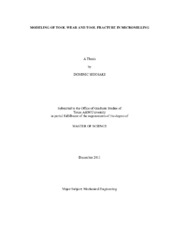Modeling of Tool Wear and Tool Fracture in Micromilling
| dc.contributor.advisor | Gentleman, Molly | |
| dc.contributor.advisor | Hung, Wayne | |
| dc.creator | Shiosaki, Dominic | |
| dc.date.accessioned | 2012-02-14T22:20:04Z | |
| dc.date.accessioned | 2012-02-16T16:18:50Z | |
| dc.date.available | 2014-01-15T07:05:31Z | |
| dc.date.created | 2011-12 | |
| dc.date.issued | 2012-02-14 | |
| dc.date.submitted | December 2011 | |
| dc.identifier.uri | https://hdl.handle.net/1969.1/ETD-TAMU-2011-12-10445 | |
| dc.description.abstract | Micromachining is the next generation of precision material removal at the micro scale level due to the increase in miniaturization of commercial products. The applications of this technology extend anywhere from electronics to micro scale medical implants. Micromilling has the potential to be the most cost effective and efficient material removal process due to ease of use and accessibility of the tools. This research analyzes vibration of a high speed spindle and then studies micromilling of aluminum and titanium. Finite element analysis and tool modeling compliment experimental data. Cumulative tool wear based on Taylor model shows decreasing tool life with increasing feed rate and increasing cutting speed on aluminum. Inconsistent results are seen when micromilling titanium due to premature chipping of tool noses. A significant nose wear plastically deforms a micromilled subsurface and is verified with microstructure study and microhardness measurements. | en |
| dc.format.mimetype | application/pdf | |
| dc.language.iso | en_US | |
| dc.subject | micromilling | en |
| dc.subject | titanium | en |
| dc.subject | aluminum | en |
| dc.title | Modeling of Tool Wear and Tool Fracture in Micromilling | en |
| dc.type | Thesis | en |
| thesis.degree.department | Mechanical Engineering | en |
| thesis.degree.discipline | Mechanical Engineering | en |
| thesis.degree.grantor | Texas A&M University | en |
| thesis.degree.name | Master of Science | en |
| thesis.degree.level | Masters | en |
| dc.contributor.committeeMember | Strouboulis, Theofanis | |
| dc.type.genre | thesis | en |
| dc.type.material | text | en |
| local.embargo.terms | 2014-01-15 |
Files in this item
This item appears in the following Collection(s)
-
Electronic Theses, Dissertations, and Records of Study (2002– )
Texas A&M University Theses, Dissertations, and Records of Study (2002– )


